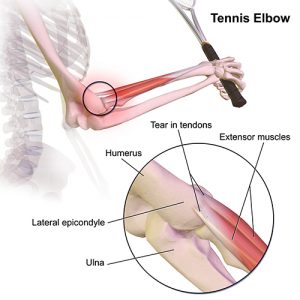
Lateral and medial elbow epicondylitis are two conditions also known as tennis elbow and golfer’s elbow respectively, and are common causes of elbow pain. Let’s take a look at the causes, symptoms and treatment suitable for elbow epicondylitis.
Elbow epicondylitis is a common cause of elbow pain and can occur on either side of the elbow. Lateral epicondylitis occurs on outer side of the elbow is often called Tennis Elbow.

Medial epicondylitis occurs on inner side of the elbow and is often called as Golfer’s Elbow.

Causes of Elbow Epicondylitis
Both conditions most commonly arise by overuse of the tendons that stabilise or move the wrist up and down. These muscles can be overloaded by repeated or sustained lifting and grasping tasks such as hammering, painting or racquet sports. This causes degeneration of the tendon that attaches these muscles to the elbow. Less commonly, a direct blow or gripping a large, sudden load can cause swelling or a tear. This can lead to overuse and subsequent degeneration.
Symptoms of Elbow Epicondylitis
Symptoms include pain and tenderness at the elbow over the medial or lateral epicondyle. This worsens usually with gripping and lifting activities and can refer down into the forearm. Weakness of grip is commonly seen to and at times, elbow motion and be painful too.
Treatment of Elbow Epicondylitis
Elbow epicondylitis conditions generally take a 12-18 month period to resolve. Effective treatment includes use of a manual therapy, specific strengthening and stretching exercises and temporary use of a counterforce elbow brace or wrist brace. Non-steroid anti-inflammatory medications and steroid injections can help relieve pain.

Please feel free to contact me should you be experiencing this and need some assistance
Article Reference: Hand Therapy Group
